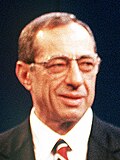Campaign
Initially, most expected U.S. senator Al D'Amato to be the Republican and Conservative nominee for governor in 1994. D'Amato began what looked like the beginnings of a campaign in September 1993 when he attacked Cuomo's record as governor, claiming that New York had become "the taxasaurus and spendasaurus capital of the nation." However, less than a month later, D'Amato decided not to run; he, correctly, predicted that his party might take control of the U.S. Senate in the 1994 elections, which would make him chairman of the Senate Banking Committee.
After considering other potential candidates, D'Amato—in conjunction with state GOP chairman William Powers—endorsed the candidacy of State Senator George Pataki. Pataki was perceived as a candidate who could garner the support of the party's moderate and conservative factions. [10] [11] [12] Lewis Lehrman, the 1982 gubernatorial nominee who narrowly lost to Cuomo, publicly flirted with a run, but ultimately didn't mount a candidacy. [13]
Former gubernatorial candidate Herbert London declared his candidacy on October 5, 1993. Running on a platform of tax cuts, reductions in state Medicaid and welfare payments and social conservatism, London was critical of both Cuomo and D'Amato. However, London's social conservatism and poor fundraising caused many party leaders to believe that he had no chance of defeating Cuomo. [14] [15]
On January 4, 1994, Evan Galbraith, a businessman from Manhattan and former ambassador to France under the Reagan Administration, decided to explore a potential gubernatorial bid. (Galbraith had also previously been a candidate for governor in 1990, but a court declared him eligible due to residency issues.) He quickly received endorsements from several notable figures, among them Henry Kissinger and William F. Buckley, Jr. Galbraith was considered by some as an alternative to London, holding similar positions but able to appeal to a larger base of voters. Galbraith formally declared his candidacy on April 29; by this time, however, most conservatives had coalesced around either London or Pataki. [16] [17]
Pataki formally declared his candidacy on March 14, but had been actively preparing for a campaign since the previous fall with the support of D'Amato and Powers. Senate Majority Leader Ralph Marino refused to support his nomination, angry over Pataki's association with Change – New York which had worked to prevent Marino's reelection. There was also concern over Pataki's position on the abortion issue, with organizations on both sides of the issue not being satisfied with his "middle-ground" approach. [18]
Former U.S. representative Bill Green declared his candidacy on March 18, hoping to become the moderate alternative to Pataki and London. Green claimed that he was conservative on fiscal issues while "sensibly compassionate" on social issues. His bid was badly damaged when Michael Long, Chairman of the Conservative Party, indicated that he did not believe that Green could receive Conservative support. [9]
Former State Party Chairman Richard Rosenbaum declared his candidacy on March 23. His platform was very similar to that of Bill Green but went even further, supporting Medicaid-financed abortions and tighter restrictions on guns. He also managed to create a much larger campaign chest of about $1.2 million. Rosenbaum decided against trying for an automatic ballot spot through the convention process; a Republican of the Rockefeller mold, he did not believe he could attain the required 25% of the vote. Instead, Rosenbaum opted to petition his way onto the ballot. [8] [19] [20]
J. Patrick Barrett, a businessman from Syracuse who was expected to join the race, dropped out on May 20 when he came to the conclusion that he could not obtain the necessary support at the state convention. [21]
At the Republican convention, Pataki won the overwhelming support of the delegates present. Herbert London, the runner-up, fell short of the 25% showing that he needed to obtain a place on the party's primary ballot. [22]




